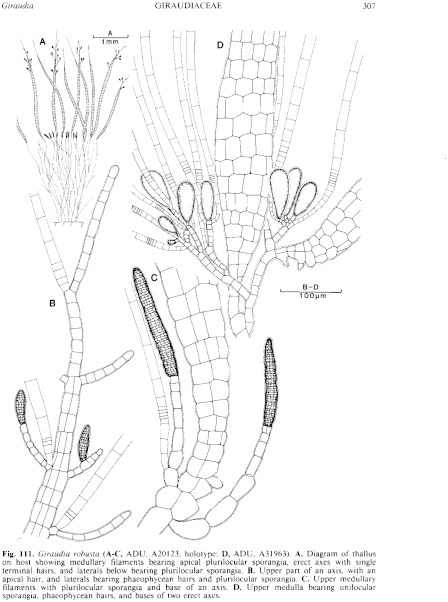|
|
|
|
|
|||||||||||
|
Electronic Flora of South Australia Species Fact Sheet
Phylum Phaeophyta – Order Dictyosiphonales – Family Giraudiaceae
Thallus (Fig. 111A) medium to dark brown, (1–) 3–6 (–8) mm high, pulvinate with free, stiff, erect axes, epiphytic on Posidonia and Amphibolis (rarely on fucoid algae). Basal plate monostromatic, of loose or compact radiating filaments on the host surface. Medullary filaments strongly developed (Fig. 111A), forming a stalk (0.5–) 1–3 mm long to the upper polystichous axes; filaments subdichotomous, cells terete below, becoming pyriform to ovoid above, 10–20 (–35) µm in diameter and L/B 1–6, with buttress rhizoids formed in the upper medulla, and the upper cells bearing the erect axes. Erect axes (Fig. 111C,D) stiff, terete, 1–3 mm long, arising from a uniseriate or 2–3 cells broad base below the meristematic zone which persists only to maturity, (70–) 100–200 µ broad centrally with tiers of 5–8 (–9) cells, then tapering to the uniseriate apex (often several cells long) which usually continues as a single phaeophycean hair (Fig. 111B); uni- or biseriate laterals usually occur near apices of axes; cells of mature axes tending to become slightly six-sided in face view (Fig. 111D) due to displacement in successive tiers, 15–30 µm across and L/B 1–2.5, with numerous discoid phaeoplasts each with a pyrenoid and prominent physodes. Phaeophycean hairs terminal and lateral from the upper axis cells, solitary, 15–28 gm in diameter.
Microthallus myrionemoid 0.5–1 mm across, with short, erect, filaments 200–250 µm and 10–15 cells long, 12–15 µm in diameter, cells L/B 1.5–2, with long, narrow ascocysts, phaeophycean hairs and terete, multiseriate plurilocular sporangia.
Reproduction: Plurilocular sporangia of two kinds: (1) borne laterally from bases of erect axes (Fig. 111C), pedicellate, simple, terete to lanceolate, multiseriate, 250–500 µm long and 35–40 µm in diameter, and (2) borne laterally on upper laterals of erect axes (Fig. 111B), sessile or pedicellate, elongate ovoid to conical, 30–80 µm long and 15–20 (–25) µm in diameter. Unilocular sporangia (Fig. 111D) borne on upper medullary cells at base of erect axes, elongate ovoid to pyriform, 120–250 µ long and 40–50 (–60) µm in diameter.
Type from Pennington Bay, Kangaroo I., S. Aust., on Posidonia coriacea, drift (Womersley, 11.ii.1956); in ADU, A20123.
Selected specimens: Nancy Cove, Rottnest I., W. Aust., on Posidonia sinuosa, 1–2 m deep (Gordon-Mills, 7.xii.1984; ADU, A56618). Lucky Bay, Esperance, W. Aust., on P. australis, upper sublittoral ( Woelkerling, 30.i.1978; ADU, A49268). Coffin Bay, S. Aust., on P. sinuosa 3–4 m deep (Womersley, 4.xii.1975; ADU, A46932). Elliston, S. Aust., on P. sinuosa, 7 m deep (Shepherd, 20.x.1970; ADU, A37609). Tiparra Reef, S. Aust., on P. sinuosa, 5 m deep (Shepherd, 24.xi.1970; ADU, A37710). Barker Rocks, Yorke Pen., S. Aust., on P. sinuosa, upper sublittoral (Womersley, 24.ix.1967; ADU, A31963). Stanley Beach, S. coast, Kangaroo I., S. Aust., on P. sinuosa, drift (Womersley, 27.i.1957; ADU, A20821). Aldinga, S. Aust., on P. australis in reef pool (Skinner, 31.x.1978; ADU, A49783). Lady Bay, Normanville, S. Aust., on Scaberia, drift (Skinner, 12.x.1977; ADU, A48575). Robe, S. Aust., on Posidonia, drift (Abbott, 7.xi.1965; ADU, A29636). Bridport, Tas., on P. australis, drift (Skinner, 23.ii.1978; ADU, A49182).
Distribution: From Rottnest I., W. Aust., to Robe, S. Aust. and the north coast of Tasmania.
Taxonomic notes: G. robusta differs from G. sphacelarioides in having a much more strongly developed medulla, often forming a squat stalk bearing the erect axes, and erect axes with tiers of usually 5–8 cells (rather than 10–15), with the cells in each tier becoming displaced and tending to be six-sided, in having a uniseriate apex bearing lateral branches and a single, broader, apical phaeophycean hair, and in forming only elongate, discrete, simple, plurilocular sporangia, together with unilocular sporangia.
References:
SKINNER, S. & WOMERSLEY, H.B.S. (1984). Southern Australian taxa of Giraudiaceae (Dictyosiphonales, Phaeophyta). Phycologia 23, 161–181.
The Marine Benthic Flora of Southern Australia Part II complete list of references.
Publication:
Womersley, H.B.S. (14 December, 1987)
The Marine Benthic Flora of Southern Australia
Part II
©Board of the Botanic Gardens and State Herbarium, Government of South Australia
Illustration in Womersley Part II, 1997: FIG. 111.

Figure 111 enlarge
Fig. 111. Giraudia robusta (A–C, ADU, A20123, holotype; D, ADU, A31963). A. Diagram of thallus on host showing medullary filaments bearing apical plurilocular sporangia, erect axes with single terminal hairs, and laterals below bearing plurilocular sporangia. B. Upper part of an axis, with an apical hair, and laterals bearing phaeophycean hairs and plurilocular sporangia. C. Upper medullary filaments with plurilocular sporangia and base of an axis. D. Upper medulla bearing unilocular sporangia, phaeophycean hairs, and bases of two erect axes.

|
Email Contact: State Herbarium of South Australia |

|